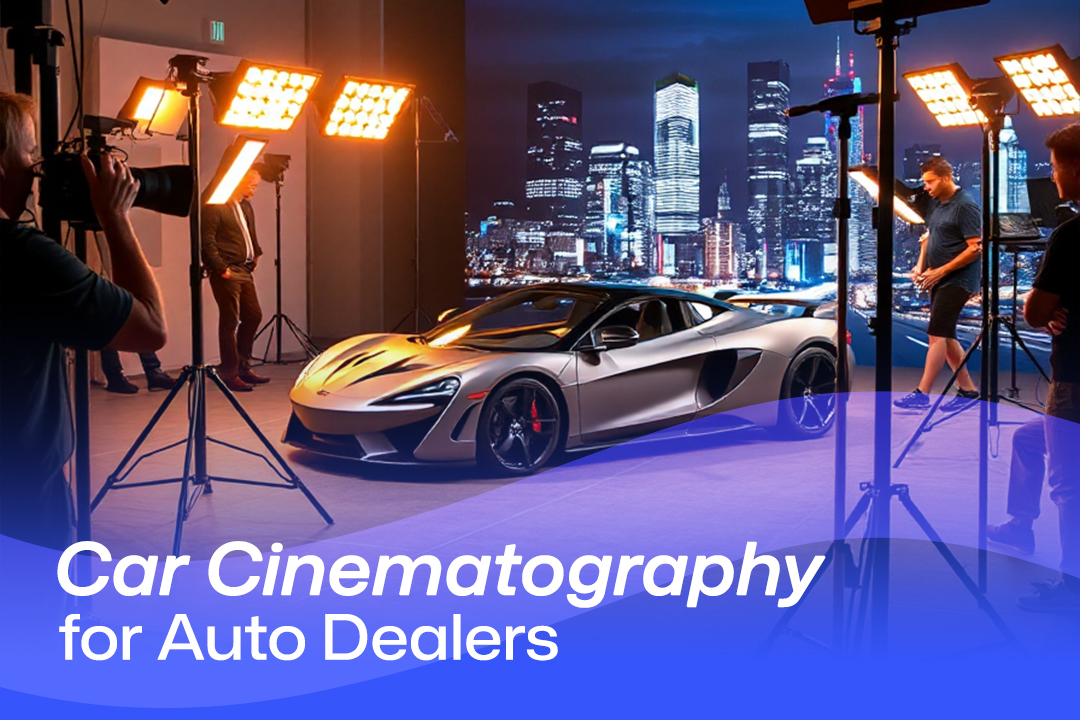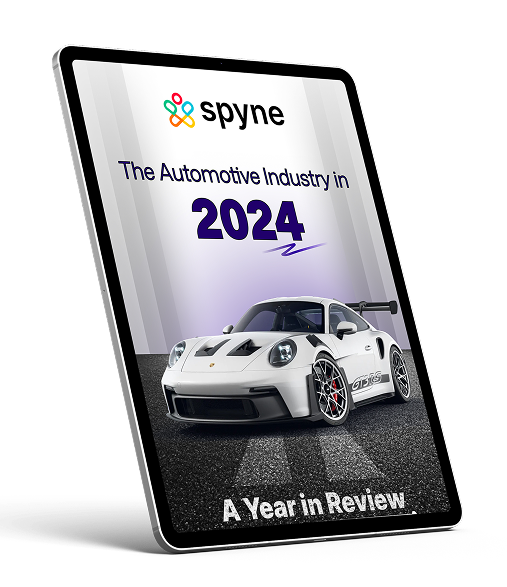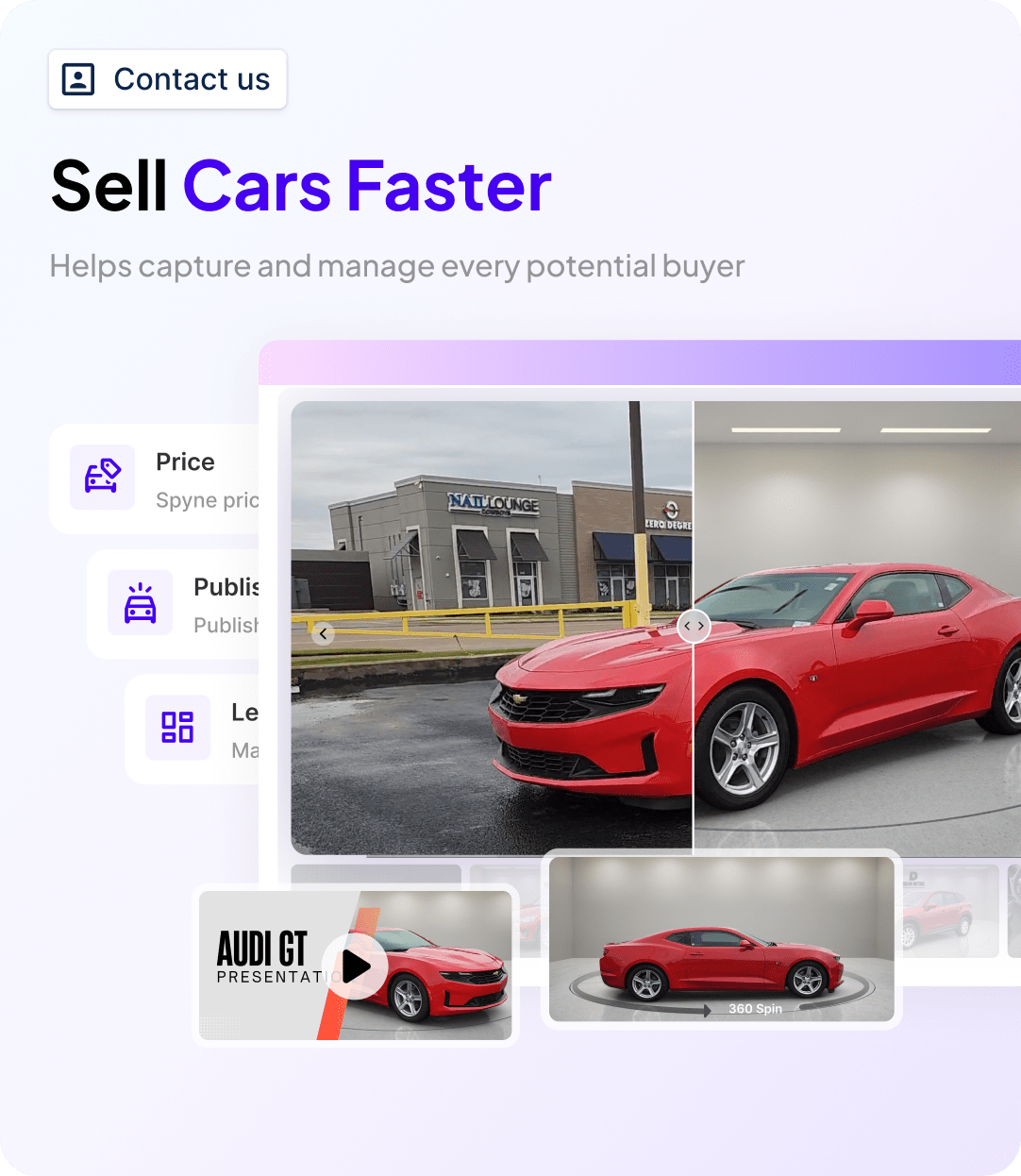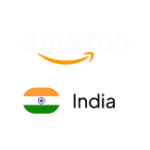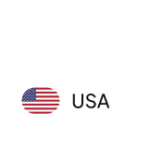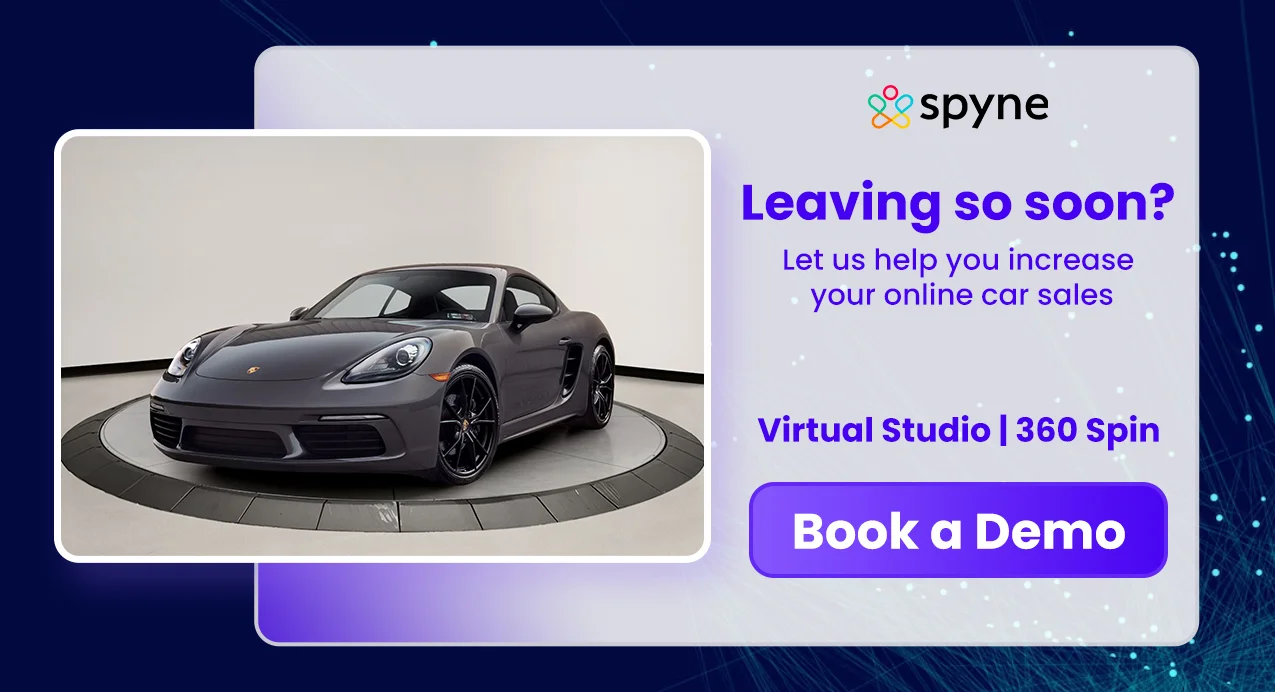As we step into 2025, car cinematography has taken over the auto industry. With decreasing attention spans and an increasing need for visuals, buyers don’t just want videos; they need them. So much so that while researching cars, buyers aren’t just depending on blogs and infographics. Instead, more than 50% of shoppers are turning to videos for more information. From model reviews to comparisons and how-tos, each form of content is a crucial part of the buyer’s journey.
Thus, close-ups of roaring engines or intricate interior shots can make all the difference in seizing attention. As a car dealer, you must showcase cars dynamically and creatively while blending storytelling with visuals. But getting a camera and capturing some shots isn’t enough anymore. You need to understand the art and science behind car scene cinematography. Explore all of that and much more in this blog. Keep reading!
What is Car Cinematography?
Cinematography is all about filming automobiles in a visually appealing and emotionally engaging way. For this, you need to blend technical skills and creative storytelling. Using the right equipment and lighting also helps showcase the car’s design, personality, and performance.
Further, you need to add a variety of shots. For instance, high-speed action shots of cars moving through scenic roads can evoke interest and excitement. While close-ups help highlight interiors and understand the car. Doing this right adds life to the videos making them seem real and relatable.
Now, you might wonder – how can car cinematography be useful for car dealers? Let’s think of it like this.
Most auto shoppers like to research before purchasing. The first place they visit isn’t a shop but an explainer video online. But would a shopper buy a car if they find a low-quality video with minimal information? Or would they be attracted by a high-quality detailed video with close-ups? I would say the second one because first impressions matter.
This is the first, most important reason to invest and film car cinematography. Other than that, it is one of the best ways to present a car, here’s why:
- Visual Appeal: Video is the #1 type of content consumed by people. That’s because it grabs attention and satisfies the viewers. Thus, professional shots highlighting features are a crowd-pleaser.
- Emotional Connection: A well-crafted video of the car interior doesn’t just appeal to the audience visually. It leaves them with the experience of driving the car without even stepping out of their homes. Thus, evoking emotions and memorability.
- Engaging: While high-quality visuals do attract viewers, adding a storyline also engages them. They get lost in the video and relate to the automobile.
- Authenticity: Videos give a realistic view of the vehicle to those interested. Making them believe it is not just a page online but real. This builds trust and credibility.
- Differentiation: Since cinematography is still a rising marketing technique, many dealers aren’t using it. Thus helping you stand out. However, your videos must be innovative and customer-focused to create a lasting effect.
Step-by-Step Guide to Shoot a Car Scene (Manual + AI)
89% of consumers want more video content for brands. And while the idea of car cinematography may seem exciting, it is also challenging. Especially because basic videos aren’t enough anymore. People want appealing visuals that showcase the automobile and leave a lasting impression.
Getting all of this right in one go is definitely not easy. But, we’ve got you. Here is the complete stepwise breakdown of the process for best results:
Build a Concept & Storyboard
Planning out the purpose and scenes before car cinematography is crucial to ensure viewer engagement. Thus, start by defining the scene’s purpose, will it have action or a character moment? You also need to choose a location and ways to drive the plot ahead.
Next comes storyboarding. This is basically imagining what your video will be like by visualizing each scene shot by shot. Be sure to get specific and think of camera angles, pacing, or movement.
Finally, understand the car. While cinematography is about shooting, knowing the condition of the automobile is crucial in car merchandising. This ensures all the elements in the video complement it instead of the other way around.
Choose a Location
Now it’s time to get in some scouting. You can create a list of locations suitable for your plot. Safety always comes first, so choose a spot with minimal traffic disturbance.
Also, focus on variety, don’t stick to one type of location. Find diverse backgrounds in cities, the countryside, or highways. These don’t just elevate the film car cinematography but also add visual interest.
Once you find the best area, go ahead and look into permits. Obtain any necessary permissions for filming.
Consider Crew and Equipment
Other than location, these are the second most important element of car cinematography. The right crew understands your needs and thoughts. This ensures the final video is exactly how you wanted. Some essential crew members to have on the team are the director, cinematographer, cameraman, sound recordist, grip, and gaffer.
Once you have the necessary manpower, you can go ahead and look into equipment. This includes cameras, lenses, sound, and lighting. For the camera, choose one with good low-light performance. Lenses should also be one with both wide shots and close-ups.
In the case of sound, go for a good shotgun microphone. It will capture every single detail like engine and tire sounds. Practical lights like car headlights or streetlights are a quick and cost-effective option. You can further supplement them with additional lights if needed.
Implement Safety Protocols
Car scene cinematography with action shots often poses safety hazards for drivers. Thus, you need to ensure intensive measures. For instance, implement traffic control for the safety of the film crew and the public. Stunt drivers must be employees where required. Additionally, an emergency plan should always be kept on hand.
Start Shooting
When everything is set, you can start shooting. Some elements that require special attention are master shot, coverage, camera movement, sound recording, and lighting.
For the master shot, it is always best to start with a wide angle, showcasing the environment.
Focus on Coverage and Camera Movement
Coverage offers various angles to try out. Car interior cinematography focuses on the driver and passenger. So capturing their reactions and interactions is a must. In contrast, exterior shots catch motion from every angle. Finally, you have POV shots, these simulate the driver’s perspective.
Moving on camera movement should be such that they follow the car. This can be done by keeping the camera on a dolly or gimbal. Car shots from above also look good. However, handheld shots create the ultimate dynamic and immersive feel.
Pick the right sound and lights
Sound recording is done to capture dialogues. This can be done using boom mics or Lavalier microphones. You should also record engine sounds, ambient sounds, and tire squeals on the location.
As for lighting, you have 2 options either utilise natural light or go for artificial ones. If shooting outside, natural light is the best option, especially during golden hours. However, studio shoots require practical and supplemental lighting to enhance mood and atmosphere.
Post Processing and Editing
Your work doesn’t end when the shoot is finished. Rather, the real car cinematography starts now. Start by choosing all the clips that you like and discard the ones that you don’t. Then assemble them into a cohesive and engaging sequence.
Once you’re satisfied, add visual effects. You can use VFX to enhance the scenes. For instance, try out green screens, CGI, or digital matte painting. Sound design is another important element. You can edit and mix dialogue to enhance the cinema. Adding sound effects like engine sounds, crashes or tire squeals is also a good option. Integrating music can enhance the mood and pacing. Color grading the footage further gives the desired feel and look.
Promote your Video
Finally, when you’ve edited the cinema to your heart’s content, go ahead and check out the results. You can either post this on your website or newsletter. To get more audience, sharing on social media or YouTube is a great option. These promotion techniques can also drive inquiries and sales.
Integrate AI into the Process
According to Worldmetrics, 70% of movies have started integrating AI during production. There are many techniques you can use. First up, these tools optimize schedules, coordinate crew members, and manage locations. Or you can use it as an assistant to help with camera settings, basic shot compositions, and lens choices.
AI also accelerates VFX and post-production tasks. It can be your savior for background removal, noise reduction, or object replacement. Sound design can also be altered with AI tools. You can perform small tasks like enhancing audio quality or bigger ones like generating realistic audio.
By following these steps, you can leverage AI to plan, shoot, and produce car cinemas. However, always consider factors like budget, timeframe, creativity, and communication beforehand.
Car Cinematography Tips: How to Film Cars Like a Pro
The above breakdown simplifies cinematography for dealers to perform. But there are some common mistakes made by many. These should be avoided as they disrupt the overall cinema experience and drive away potential customers.
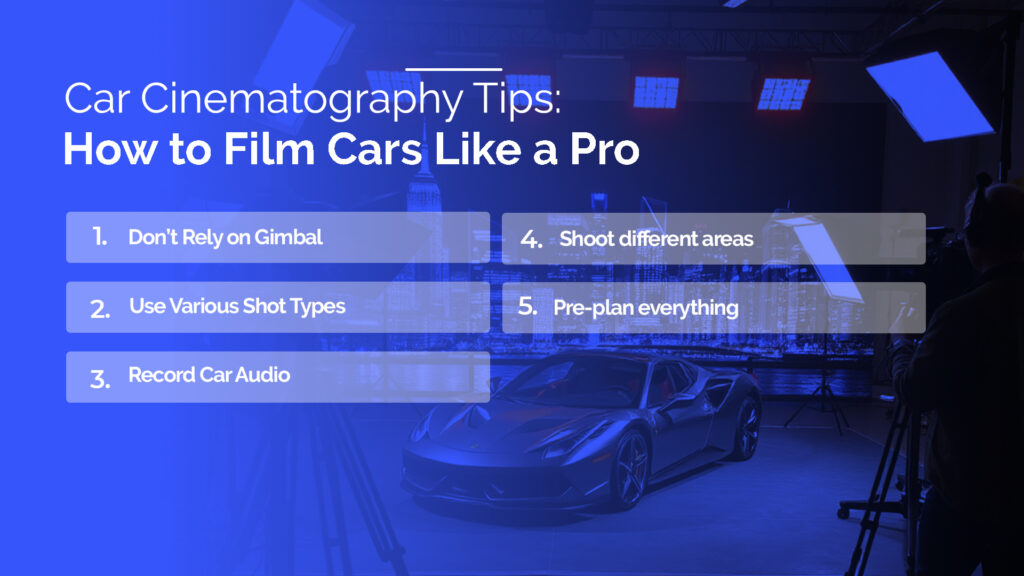
Let’s look into some of these below to ensure your car film turns out perfect:
Don’t Rely on Gimbal
While gimbal shots provide a polished feel with smooth and cinematic movements, overusing them can destroy car cinematography. Instead, you need to incorporate a mixture of techniques. For starters, you can simply make gimbal shots more dynamic. You can switch up things by using a handheld camera, These evoke interest by adding an organic feel. The slight natural shake doesn’t look like a flaw, rather unique and raw.
Tripods are also an amazing tool for film car cinematography. They provide stability ensuring clean shots without constant movement. Another cost-effective technique is to place your camera on the floor. Then drive the car into the frame. This adds variety to each shot creating a larger impact.
Use Various Shot Types
Imagine watching a car film with the same kind of shot. Wouldn’t it be so boring? This is why you need to vary your shots and keep the footage dynamic. You can start with a wide angle to show the location. Then move to close up or medium angle. This keeps your viewers engaged and adds depth to the cinema.
If you have a higher budget, drone shots are an amazing addition. They help change the dynamics to keep the viewer hooked. You can capture stunning motion shots with a drone to mix things up.
Record Car Audio
As mentioned earlier, car audio may be boring to some, but it is intriguing for many. The thunderous roar of a V8 engine, supercharger whining, or blow-off valve of a turbo excites car lovers.
Thus, by adding these you don’t just attract viewers but also satisfy their needs. To record these sounds from the front, you can tap a lav mic on the side mirror. It will pick up noises from the car front while ignoring the wind. Later on, use these audios during sound design to enhance the overall effect.
Shoot different areas
Understanding every feature of your car is crucial before shooting. This helps you to capture important elements, aspects, and features. For instance, in a Lamborghini, the beautiful air inlets are an attractive feature. While for Porsche, don’t miss out on the huge brake kit.
Things like emblems, brake calipers,s and exhaust tips can also be shot. Additionally, one should never neglect the interiors. For this, you can pop the hood or open the door.
In case, your car doesn’t have something too special, it is still important to get the features. This will help take your car’s cinematography to the next level.
Pre-plan everything
There are many aspects of panning the film car cinematography that you need to know. Firstly, scouting the location. This helps ensure that issues don’t arise while filming. For example, you should know about the traffic situation, trespassing warnings, or unsightly debris. It also allows you to stay safe while shooting. You can avoid any flat tires due to nails, sharp debris, or glass shards.
Secondly, a mood board always helps. It helps you decide the look and feel of the shoot in your mind. So that you can develop and determine the final shot accordingly. You simply need to compile past shots or screen shots of work you admire. This way you are prepared when shooting and know what to capture especially during night car cinematography.
Top Techniques for Stunning Car Cinematography
While car scene cinematography is all about experimenting and finding what suits you, some techniques always work. When done right, these can give shots that captivate the audience and engage them. Thus, filmmakers can elevate their cinematography.
Here are the top techniques to put to work for best results:
- Front windshield: These shots put the viewer directly in the driver’s seat creating an immersive experience. Such that the shopper can experience the car from the comfort of their homes. However, there are a few things to consider. The reflections should be minimal for clear visibility. You can use a polarizing filter for overcasts. Camera stabilization helps keep footage smooth during driving scenes. Additionally, you must frame the shot to highlight scenery or roads.
- Over the shoulder: If you want to capture the driver’s reactions and emotions while maintaining a view of the environment, this technique of for you. To get this right, you must focus on camera placements, depth of field, and movement. The position of the camera is behind the shoulder so that it captures the face and road ahead. A low depth of field isolates the driver’s face, making it cinematic. While smooth camera movements avoid distractions.
- Close-up passenger POV: This perspective captures unease, excitement, and wonder from the passenger’s point. The key is to focus on the passenger’s face and interactions with the surroundings. Further, the camera movements should be subtle to reflect emotions. Adding sounds like wind, music, or engine noise further enhances the experience.
- Back seat (French over): This is the best shot if you want to create a sense of mystery, observation, or tension. It doesn’t show much while at the same time revealing tons of the background. Start by focusing on the front seat occupants from behind. This emphasizes interactions and the road ahead. Then shoot from a higher angle to capture the scene. You can also use soft background sounds to enhance the mood.
- Rearview mirror shot: A mirror shot is one of the best forms of car cinematography. It looks aesthetic and feels immersive, giving viewers an all-rounder experience. At the same time, showing the driver’s awareness of surroundings and threats. The camera must be positioned directly behind the mirror for good perspective.
- Side mirror shot: This is a dynamic way to shoot the car’s movement and design along with the passing scenery. To get this, start by positioning the camera on the side mirror. Then use tracking shots or smooth panning to follow the car’s movements. Finally, use natural or artificial lights to add visual appeal.
Best Lenses for Camera Car Scene Cinematography
Finding the right lens for your car cinematography can be a tedious job. There are a bunch of options to choose from. However, to pick the right one, you need to understand the needs and requirements of the project. Hereafter, the biggest question that comes to mind is – Should one go for prime or zoom lenses?
Well, prime lenses work best for close-ups. For instance, if you wanna shoot badges or logos on the car. It is also a good choice to blow up the background and make the car pop.
As for zoom lenses, they’re easier to work with, thus the best options for beginners. It gives you the ability to zoom in and out depending on the proximity of the action scene. So that you don’t have to direct the car to move according to you. This lens is especially useful when doing rollers.
Now that you know the basics of prime and zoom lenses, let’s look at some of the best picks that you can always depend on:
- 24-70 mm: If you can pick just one lens for car cinematography, this is the one to go with. It is super versatile, working for any situation to cover the necessary range. From panning shots, rollers, and statics to light painting, it never lets you down. The only drawback is it isn’t effective during night car cinematography.
- Prime Lens: This lens is especially useful for close-ups and working with people. It is sharper than zoom lenses. Thus, making a faster lens. This helps you blow out the background and add depth. However, you will need more backup for longer focal length and the background will be out of focus.
- 70-200mm: This big zoom lens works in 2 situations. First when you’re far away from the action, like at a racing event. Second when you need static shots with blown-out backgrounds. The long focal length gives major depth control, especially during static shots. However, you can’t use it for rollers.
How Spyne Can Help in Car Cinematography Shoots
While car cinematography gives beautiful results that help attract shoppers and initiate action. They are also time-consuming and require a good amount of capital. This is where Spyne AI comes in. It helps you shoot car cinemas with extensive details at a minimum cost. Most car dealers like to use it for two most common cinemas:
- 360 spins: Moving around the car to get a 360 shot is often tiring. Especially because you need to go back and forth consistently for best results. With Spyne’s 360 spin, not anymore. All you need to do is shoot a basic 360 video. AI does the rest from changing the background to making it hypersmooth.
- Video Tours: Making in-depth car guides is another painful task. It doesn’t just require a good cinematographer but also a voice artist and a host. This makes the whole process lengthy. Spyne’s AI-powered editing provides voice cloning, multilingual voiceovers ,and avatars. So that you can do the most in less time and effort.
So, why wait? Try Spyne now!
Conclusion
Good car cinematography can be a game-changer for car dealers. However, to do so, you need to start by planning everything out. Additionally, hiring the right crew and getting equipment is a major factor. This makes the whole process quite time-consuming and expensive.
The solution to this is – integrating AI. You can use AI not just to edit but also to shoot videos and coordinate members. This cuts down a lot of time and cost. Plus, creative additions like VFX help you truly stand out from other dealers. In turn, helping you form a genuine connection and make sales.

